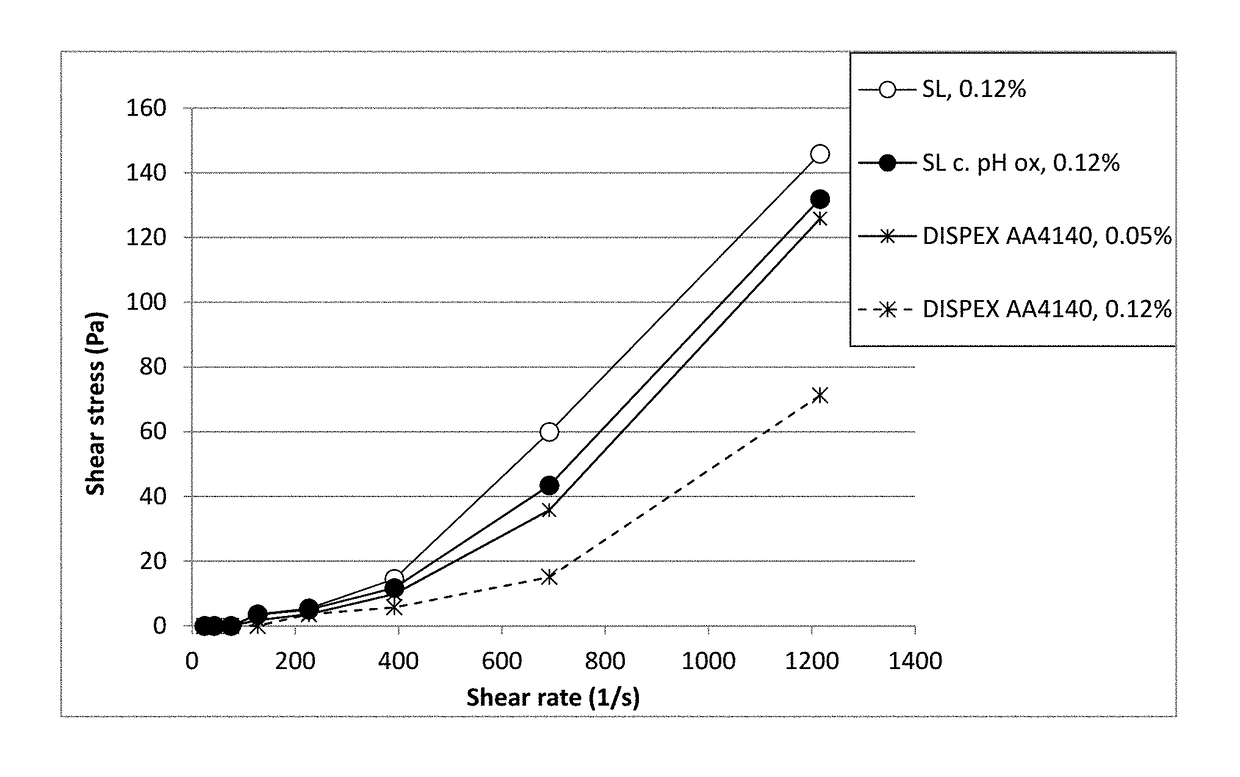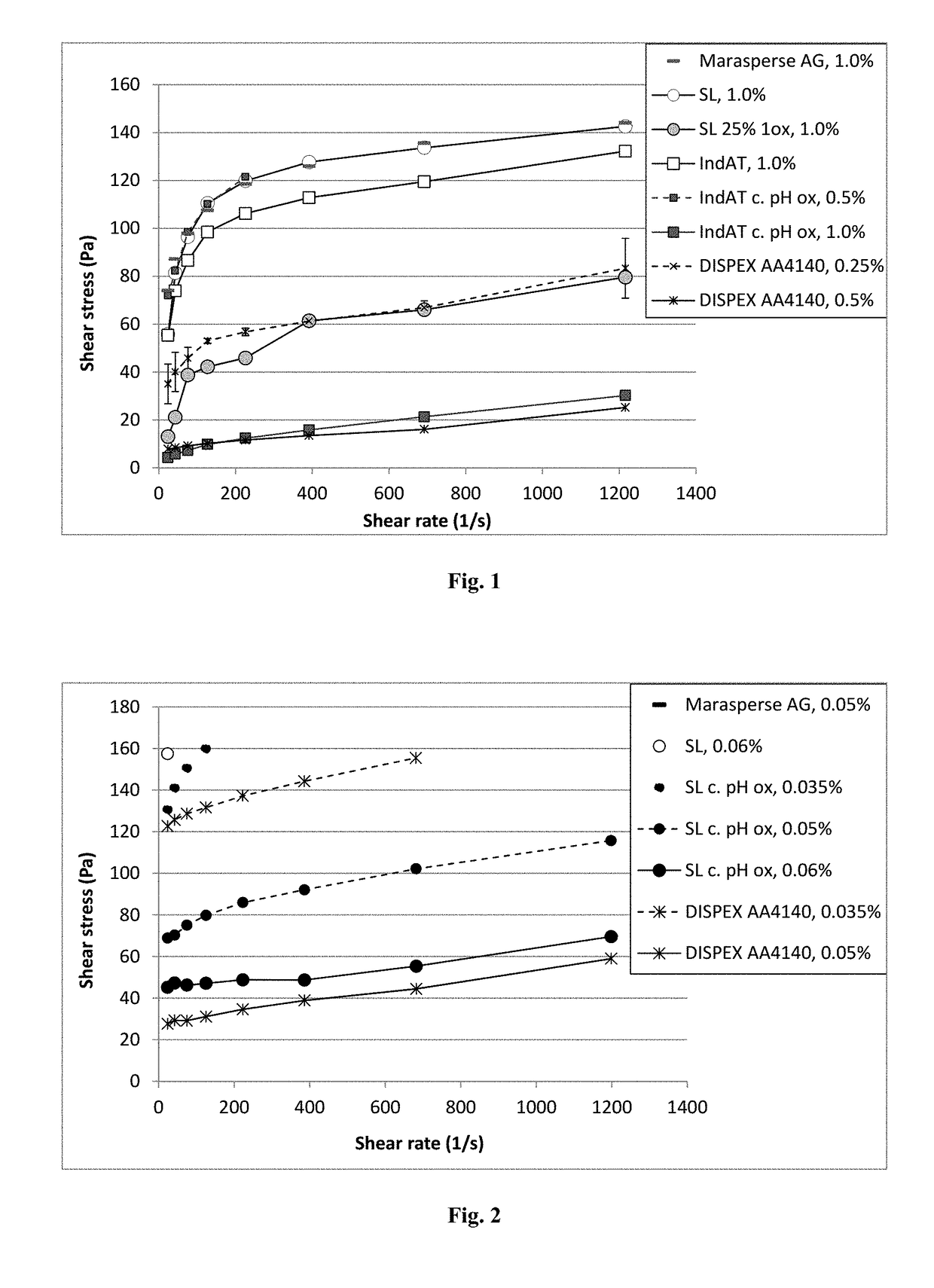Alkali-O2 oxidized lignin as dispersant
a technology of oxidized lignin and alkali-o2, which is applied in the field of alkali-o2 oxidized lignin as dispersant, can solve the problems of limited effect, use of alkali-osub>2/sub>oxidized, and inability to disclose the dispersing performance of alkali-osub>2/sub>oxidized paints and coatings, and achieve good dispersing performan
- Summary
- Abstract
- Description
- Claims
- Application Information
AI Technical Summary
Benefits of technology
Problems solved by technology
Method used
Image
Examples
example 1
PCC (Precipitated Calcium Carbonate, CaCO3) 34 w-% in Water (Including Dispersant Solution)
[0057]Dispersants of the invention decreased the yield stress in PCC paste demonstrating the dispersing performance. With a dose of 1.0 w-% on pigment, SL 25% 1 ox provided roughly the same yield stress than commercial synthetic dispersant (DISPEX AA140) with a dose of 0.25 w-%. The constant pH oxidation indicated also to be a means of producing an efficient dispersant: with a dose of 1.0 w-%, IndAT c. pH ox showed equal performance than DISPEX AA140 with a dose of 0.5 w-%. The dispersing performance of commercial lignosulfonate (Marasperse AG) was clearly lower than that of the oxidized lignin. Unmodified lignins were not providing decent dispersing effect (FIG. 1).
example 2
Titanium Dioxide (TiO2) 70 w-% in Water (Including Dispersant Solution)
[0058]Dispersant of the invention (SL c. pH ox) decreased the yield stress in TiO2 paste clearly better than the unmodified lignin (SL): about 45 Pa vs. 160 Pa with an equal dosing of 0.06%. The dispersing performance of SL c. pH ox was almost the same with a dosage of 0.06% than in the case of DISPEX AA4140 with 0.05%. Marasperse AG (0.05%) did not plasticize the paste enough, and thus the yield stress was too high to be measured.
[0059]In PCC paste (Example 1), the dispersants of the invention (SL 25% 1 ox, IndAT c. pH ox) functioning well had clearly higher molecular mass (Mw) if comparing to the results in the case of TiO2 paste, wherein the dispersant of the invention (SL c. pH ox) having rather low Mw showed high dispersing performance (FIG. 2).
example 3
Kaolin (Aluminum Silicate, Average Particle Size 2 μm) 50 w-% in Water (Including Dispersant Solution)
[0060]Dispersants of the invention (SL c. pH ox) decreased the yield stress in kaolin more than the unmodified lignin (SL). With a dose of 0.12 w-% on pigment, SL c. pH ox provided roughly the same yield stress than commercial synthetic dispersant (DISPEX AA140) with a dose of 0.08 w-% (FIG. 3).
[0061]After 3 days of preparing the kaolin paste with the dispersant of the invention (SL c. pH ox, 0.12%) the paste turns stable by light shaking. In the case of the reference dispersant (DISPEX AA4140, 0.12%) the paste could not be turned to a stable form by heavy shaking (since most of the pigments had settled / packed in the bottom of the plastic tube, FIG. 4).
PUM
| Property | Measurement | Unit |
|---|---|---|
| Viscosity | aaaaa | aaaaa |
| Solubility (mass) | aaaaa | aaaaa |
| Content | aaaaa | aaaaa |
Abstract
Description
Claims
Application Information
 Login to View More
Login to View More - R&D
- Intellectual Property
- Life Sciences
- Materials
- Tech Scout
- Unparalleled Data Quality
- Higher Quality Content
- 60% Fewer Hallucinations
Browse by: Latest US Patents, China's latest patents, Technical Efficacy Thesaurus, Application Domain, Technology Topic, Popular Technical Reports.
© 2025 PatSnap. All rights reserved.Legal|Privacy policy|Modern Slavery Act Transparency Statement|Sitemap|About US| Contact US: help@patsnap.com



